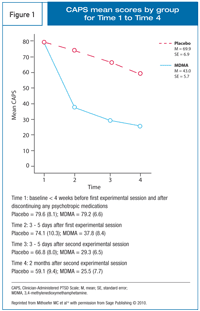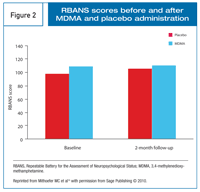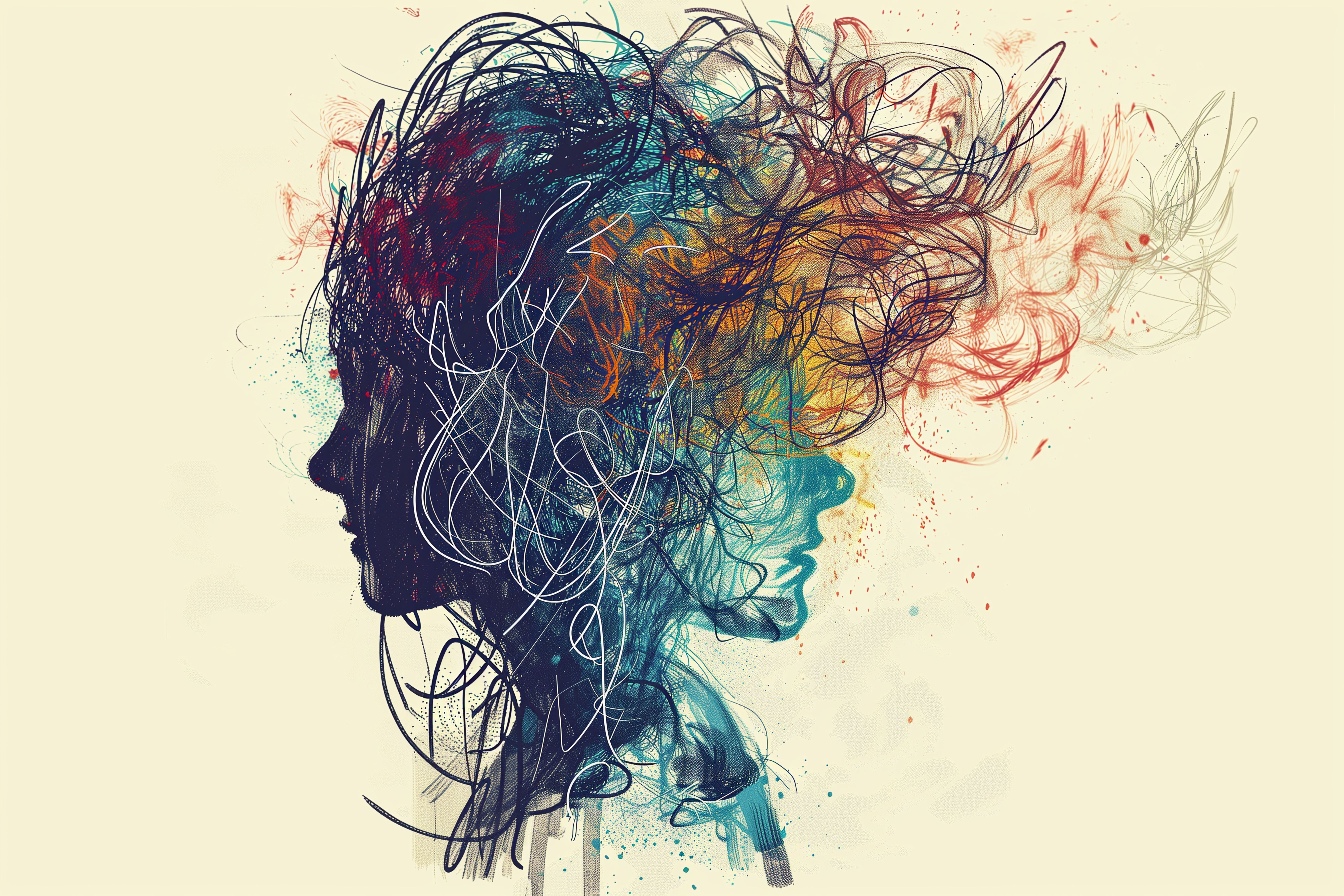Publication
Article
Psychiatric Times
Does MDMA Have a Role in Clinical Psychiatry?
Author(s):
Like every drug or technology that has therapeutic value, MDMA (3,4-methylenedioxymethamphetamine) has potential risks and benefits. Unlike most other drugs under clinical investigation, MDMA has a complex and controversial history that has delayed dispassionate scientific investigation into its therapeutic use.
Like every drug or technology that has therapeutic value, MDMA (3,4-methylenedioxymethamphetamine) has potential risks and benefits. Unlike most other drugs under clinical investigation, MDMA has a complex and controversial history that has delayed dispassionate scientific investigation into its therapeutic use. Fortunately, research efforts are now overcoming the liabilities of this history, and rigorous research that explores whether MDMA has a role in psychopharmacology is under way.
MDMA was synthesized as an intermediate chemical, and it was patented in 1912 by Merck.1 The first published report of MDMA given to patients appeared in 1978, long after the Merck patent had expired. Shulgin and Nichols2 described the effect of MDMA as “an easily controlled altered state of consciousness with emotional and sensual overtones.” Shulgin introduced the compound to colleagues who were therapists, and the use of MDMA as a catalyst to psychotherapy was taken up by a number of psychiatrists and other therapists in the United States. A few favorable reports of its use appeared in the literature, although there were no controlled clinical trials.3,4

MDMA was neither an approved medication nor an illegal substance, but as it was increasingly marketed under the name “ecstasy” and as recreational use grew, it eventually drew the attention of lawmakers. In 1985, the Drug Enforcement Administration (DEA) deemed MDMA a Schedule 1 substance despite the testimony of physicians and the recommendation of an administrative law judge who suggested that it be a Schedule 3 substance.5 Following this decision, clinical research with MDMA was severely curtailed, but in the past several years it has been gaining momentum.
Recent research
A number of phase 1 safety studies have been done in the United States and Europe, and a phase 2 trial was started in Spain but halted for political reasons unrelated to drug safety.6-15 Additional phase 2 trials are under way in the United States and Switzerland and will soon begin in Israel, Jordan, and Canada. With the exception of 1 study of anxiety associated with advanced stage cancer in the United States, these trials are all directed at studying MDMA-assisted psychotherapy for posttraumatic stress disorder (PTSD).
It is noteworthy that all of these clinical trials are using MDMA as an adjunct to psychotherapy, rather than as a stand-alone medication. The drug is administered on only 2 or 3 occasions under direct supervision by a psychiatrist and a cotherapist during prolonged psychotherapy sessions, and treatment effects are compared with those of the same therapy without MDMA. The hypothesis that MDMA catalyzes psychotherapy, now being tested with these rigorous study designs, is derived from earlier published reports of the clinical use of MDMA and is consistent with the current understanding of the pharmacology of MDMA.
In 1986, Greer and Tolbert3 published a report on 29 volunteers to whom MDMA had been administered in the presence of a male and a female therapist. The participants reported benefits such as “enhanced self-understanding [and] insight into personal patterns or problems, greater self-confidence or self-acceptance, lowered defenses [while] undergoing a therapeutic emotional process,” and “less negative thoughts or feelings.”
A study of MDMA
We recently published the first completed phase 2 pilot study of MDMA as a therapeutic agent.16 This was a double-blind placebo-controlled pilot study of MDMA-assisted psychotherapy in 20 patients with chronic, treatment-resistant PTSD. MDMA was administered to carefully screened participants under direct supervision during two 8-hour psychotherapy sessions with male and female cotherapists, using a nondirective method of therapy that is currently being manualized.17 Nondrug psychotherapy sessions prepared participants for the MDMA sessions, and follow-up psychotherapy sessions helped them integrate their experiences.
What is already known about MDMA (3,4-methylenedioxymethamphetamine) and its role in clinical psychiatry?
-Anecdotal reports of clinical use before it was placed in Schedule 1 have suggested that MDMA may have clinical utility.
What new information does this article add?
-This article discusses the promising results of the first completed clinical trial of MDMA as a potential psychiatric treatment.
What are the implications for psychiatric practice?
-Pending further research, MDMA may have a role as an adjunct to psychotherapy for posttraumatic stress disorder and other psychiatric disorders.
Standard outcome measures of PTSD symptoms-the Clinician-Administered PTSD Scale (CAPS) was the primary measure-showed that the MDMA group had statistically clinically significant improvement compared with the placebo group, which had received the same psychotherapy (CAPS improvement, P = .015; clinical improvement, greater than 30%; CAPS reduction of 83% in MDMA group vs 25% in placebo group). Figure 1 shows the CAPS results at 2-month follow-up.

Seven of the 8 placebo recipients elected to enter an open-label crossover continuation phase in which they received MDMA on 2 occasions with the same schedule of psychotherapy before and after each session. All had a similar improvement. This was a pilot study with a small total number of participants designed to test proof of concept and safety in a patient population. Despite this low power, the results did reach statistical significance.
The results of a recently completed long-term follow-up showed that 2 patients experienced symptom relapse. However, most maintained symptomatic improvement for a mean of 3.5 years.18
This study was not designed to determine the mechanism of action of MDMA-assisted psychotherapy; however, our clinical observations, as well as our formal results, can be partially explained on the basis of the current understanding of the pharmacology of MDMA. Although we observed a wide range of individual variation in the nature of participants’ experiences during and following MDMA sessions, much of the beneficial effect fell into 1 of 2 categories, both of which were experienced at various times by most patients.
Overcoming obstacles to therapeutic processing of trauma. MDMA appeared to lower fear levels while increasing access to emotions in general-including painful emotions. This created an opportunity for patients to process painful, traumatic experiences while avoiding the extremes of either being overwhelmed by emotions or experiencing emotional numbing (both common features of PTSD). One of our study participants said:
Without the study I don’t think I could have ever dug down deep, I was so afraid of the fear. In the sessions there was just no fear; that builds your confidence. When I tried in therapy before, it would send me into a tailspin.
After an MDMA-assisted session, another participant told us:
It’s like night and day for me compared to other methods of therapy. Without MDMA, I didn’t even know where I needed to go. Maybe one of the things the drug does is let your mind relax and get out of the way because the mind is so protective about the injury.
Corrective positive experiences. During MDMA sessions, the experiences of the participants were often emotionally challenging, but in addition to these challenging, painful experiences, most participants, at other times in the sessions, also had positive, affirming experiences. They often experienced a sense of comfort and joy that they may not have felt for years, and they were frequently left with a more positive perspective about the world. Consequently, the cognitive distortions and unrealistic fears that had accompanied PTSD were corrected.
For example, one man who had been sexually abused as a child told us that he had spent his adult life observing that other people were having an experience that he presumed must be what they called “happiness”-something he had not experienced and had always assumed he was incapable of experiencing. During his MDMA session, he felt happy for the first time in memory. Hopelessness was replaced by the conviction that happiness was no longer beyond his reach, and indeed, he then discovered the ability to feel happiness without MDMA.
Many other participants felt this way as well. One woman said:
I feel like I’m walking in a place I’ve needed to go for so long and just didn’t know how to get there. I feel like I know myself better than I ever have before. Now I know I’m a normal person. I’ve been through some bad stuff, but … those are things that happened to me, not who I am… This is me, the medicine helps, but this is in me.
Possible mechanisms
While the format of MDMA-assisted psychotherapy and the nondirective therapeutic approach we used are quite different from many existing treatments for PTSD, some elements of what occurs in MDMA-assisted therapy would be easily recognizable to many therapists. The first category of effects discussed above, in which MDMA appears to remove obstacles to effective trauma processing, can be understood in terms used by Foa and colleagues19 to describe obstacles to prolonged exposure therapy: overengagement and underengagement.
To be effective, exposure must be accompanied by a degree of emotional engagement or fear activation while avoiding dissociation or overwhelming emotion.20 This has been referred to as working within the optimal arousal zone, or window of tolerance.21-23 During MDMA sessions, we observed that patients with PTSD spontaneously engaged in “imaginal exposure,” and MDMA appeared to allow them to remain within an optimal arousal zone while doing so.
Further trials will determine whether the study results will evolve into clinical applications … it is likely that MDMA may find an important place in the future of psychopharmacology.
The pharmacological effects of MDMA include serotonin release; serotonin type 2 receptor stimulation; and an increase in levels of the neurohormones oxytocin, prolactin, and cortisol.24-29 Serotonin release plays an important role in producing the subjective effects of MDMA.30-33 Pretreatment with SSRIs reduces most acute subjective and physiological effects of MDMA, including effects on mood and perception. Serotonin release directly or indirectly leads to an elevation in oxytocin levels, possibly by stimulating serotonin type 1A receptors.24,28,34 Studies suggest that oxytocin plays an important role in stress response, reduces the fear response, and increases social affiliation and trust35-39; thus, elevated oxytocin levels might help patients form a therapeutic alliance and revisit traumatic experiences in an emotionally engaged state.
Elevation in oxytocin levels after MDMA administration has been associated with greater sociability and more gregarious behavior.24 MDMA has recently been shown to decrease perception of negative emotions in others and perception of threat-related signals, such as fear, which might increase social approach behavior.40 It has been postulated that prolactin release following MDMA administration may contribute to a postorgasmic-like sense of relaxation and receptivity.41 The neurocircuitry model of PTSD postulates a deficit in extinction of fear conditioning mediated by the amygdala and the ventromedial prefrontal cortex, a model supported by findings of reduced hippocampal activity and volume, increased activity in the amygdala, and decreased activation of the medial prefrontal cortex in persons with PTSD.42,43
Gamma and colleagues44 used positron emission tomography to measure cerebral blood flow 75 minutes after MDMA was given to healthy volunteers. Their findings showed increases in cerebral blood flow in the ventromedial frontal and occipital cortex and decreases in the left amygdala. MDMA may produce some of its effects through these acute changes in brain activity, which may reverse abnormalities associated with PTSD and thereby allow effective processing of traumatic memories. The nature of the effects is consistent with much of what we observed in our clinical trial.
Risks of MDMA
MDMA administration carries psychological risks, such as increased anxiety, confusion, ruminations, and dissociation.9,26,45 Our findings suggest that at the doses we used, these risks can be mitigated with proper preparation, a supportive setting during MDMA sessions, and good follow-up to facilitate integration. Some patients in our study had intense anxiety and needed reassurance during MDMA sessions, especially when the drug first took effect. Often in the days after an MDMA session, patients had second thoughts about what they had discussed during the session. With proper support, participants could successfully process these doubts and any accompanying emotions and could come to recognize these challenges as a meaningful part of healing. The fact that this close follow-up was necessary to address psychological difficulties underscores the potential problems that may be associated with MDMA in recreational settings.
In illicit settings, in addition to these psychological risks, the primary acute risks of ecstasy (which may contain varying amounts of MDMA and other substances) involve hyperthermia and dehydration or overhydration, with resulting water intoxication and cerebral edema. These complications are highly unlikely in a controlled research setting. MDMA predictably causes increases in pulse rate and blood pressure that could be dangerous for persons with underlying cardiovascular disease. We excluded patients with any serious medical problems and psychiatric problems such as psychosis, bipolar disorder type 1, and active addiction, and we did not encounter any drug-related serious adverse events.
Some controversy remains about adverse long-term neurocognitive effects in ecstasy users. Following their meta-analysis of cognitive functions of ecstasy users, Rogers and colleagues46 cautiously concluded that the drug may significantly affect verbal memory, with a lesser effect on visual memory. However, results from other meta-analyses were somewhat contradictory.47,48 A definitive conclusion about the adverse effects of MDMA remains elusive because of the considerable methodological challenges involved in studying illicit drug users; however, a very recent study by Halpern and colleagues49 that was designed to minimize these methodological problems “found little evidence of decreased cognitive performance in ecstasy users save for poorer strategic self-regulation, possibly reflecting impulsivity … which may have been a pre-morbid attribute of ecstasy users.”
More germane to an assessment of the risks of clinical administration is the fact that there has been no evidence of memory loss or other adverse neuropsychological effects after administration of a few doses of pure MDMA in medical settings in phase 1 or phase 2 studies. In our 20 participants, we measured neurocognitive function before and after 2 doses of MDMA or 2 doses of placebo and found no indication of adverse effects.16 This is represented by the Repeatable Battery for the Assessment of Neuropsychological Status (RBANS) scores shown in Figure 2.

It is important to point out that our safety data should not be taken to imply that there are no psychological and physical risks accompanying the use of ecstasy, or even pure MDMA in other settings, at higher and more frequent doses, and when used in an addictive pattern, which can be highly problematic. Like many of the drugs we use in medicine, MDMA can be dangerous when it is used inappropriately or when it is abused.
The future of MDMA in psychiatry
These early results provide encouragement that MDMA-assisted psychotherapy may prove to be a valuable treatment for PTSD. However, there is still a long way to go from promising phase 2 trials to the demonstration of safety and efficacy in much larger phase 3 studies, which would be required for FDA ap-proval of MDMA as a prescription medicine.
Additional rigorous clinical trials will determine whether interesting early results will evolve into clinical applications. Nevertheless, given the considerable clinical experience with MDMA before it was deemed a schedule 1 substance, the robust results in the first controlled trial, and the intriguing-perhaps unique-qualities of MDMA administered in the context of psychotherapy, it is likely that MDMA may find an important place in the future of psychopharmacology.
References:
Acknowledgment-The author thanks Lisa Jerome, PhD, for her thoughtful suggestions about the manuscript as well as her work on the research, and his other fellow researchers, Mark Wagner, PhD, Ann Mithoefer, BSN, and Rick Doblin, PhD.
References
1. Freudenmann RW, Oxler F, Bernschneider-Reif S. The origin of MDMA (ecstasy) revisited: the true story reconstructed from the original documents. Addiction. 2006;101:1241-1245.
2. Shulgin AT, Nichols DE. Characterization of Three New Psychotomimetics. 1978. http://www.erowid.org/references/refs_view.php?A=ShowDocPartFrame&ID=961&DocPartID=832. Accessed February 23, 2011.
3. Greer G, Tolbert R. Subjective reports of the effects of MDMA in a clinical setting. J Psychoactive Drugs. 1986;18:319-327.
4. Holland J. The history of MDMA. In: Holland J, ed. Ecstasy: The Complete Guide. Rochester, VT: Inner Traditions; 2001:11-20.
5. Beck J, Rosenbaum M. The scheduling of MDMA (“Ecstasy”). In: Inciardi J, ed. Handbook of Drug Control in the United States. Westport, CT: Greenwood Press; 1990:303-316.
6. Vollenweider FX, Gamma A, Liechti M, Huber T. Psychological and cardiovascular effects and short-term sequelae of MDMA (“ecstasy”) in MDMA-naïve healthy volunteers. Neuropsychopharmacology. 1998;19:241-251.
7. Dumont GJ, Verkes RJ. A review of acute effects of 3,4-methylenedioxymethamphetamine in healthy volunteers. J Psychopharmacol. 2006;20:176-187.
8. Freedman RR, Johanson CE, Tancer ME. Thermoregulatory effects of 3,4-methylenedioxymethamphetamine (MDMA) in humans. Psychopharmacology (Berl). 2005;183:248-256.
9. Liechti ME, Gamma A, Vollenweider FX. Gender differences in the subjective effects of MDMA. Psychopharmacology (Berl). 2001;154:161-168.
10. Hasler F, Studerus E, Lindner K, et al. Investigation of serotonin-1A receptor function in the human psychopharmacology of MDMA. J Psychopharmacol. 2009;23:923-935.
11. Kuypers KP, Ramaekers JG. Transient memory impairment after acute dose of 75mg 3.4-methylene-dioxymethamphetamine. J Psychopharmacol. 2005;19:633-639.
12. Kolbrich EA, Goodwin RS, Gorelick DA, et al. Physiological and subjective responses to controlled oral 3,4-methylenedioxymethamphetamine administration. J Clin Psychopharmacol. 2008;28:432-440.
13. Ramaekers JG, Kuypers KP, Samyn N. Stimulant effects of 3,4-methylenedioxymethamphetamine (MDMA) 75 mg and methylphenidate 20 mg on actual driving during intoxication and withdrawal. Addiction. 2006;101:1614-1621.
14. Randall S, Johanson CE, Tancer M, Roehrs T. Effects of acute 3,4-methylenedioxymethamphetamine on sleep and daytime sleepiness in MDMA users: a preliminary study. Sleep. 2009;32:1513-1519.
15. Bouso JC, Doblin R, Farré M, et al. MDMA-assisted psychotherapy using low doses in a small sample of women with chronic posttraumatic stress disorder. J Psychoactive Drugs. 2008;40:225-236.
16. Mithoefer MC, Wagner MT, Mithoefer AT, et al. The safety and efficacy of {+/-}3,4-methylenedioxymethamphetamine-assisted psychotherapy in subjects with chronic, treatment-resistant posttraumatic stress disorder: the first randomized controlled pilot study. J Psychopharmacol. 2011;25:439-452.
17. Ruse JM, Mithoefer MC, Jerome L, Doblin R, Gibson E. MDMA-Assisted Psychotherapy for the Treatment of Posttraumatic Stress Disorder, A Revised Teaching Manual Draft. 2010. http://www.maps.org/research/MDMA_treatment_manual_10_23_2010_.pdf. Accessed March 1, 2011.
18. Mithoefer MC, Wagner MT, Mithoefer AT, et al. Long term follow-up of subjects who completed a clinical trial of (MDMA)-assisted psychotherapy for treatment-resistant posttraumatic stress disorder (PTSD). Poster presented at: International Society for Traumatic Stress Studies 27th Annual Meeting; 2010; Montreal.
19. Foa EB, Keane TM, Friedman MJ, Cohen JA. Effective Treatments for PTSD: Practice Guidelines From the International Society for Traumatic Stress Studies. 2nd ed. New York: Guilford Press; 2009.
20. Foa EB, Hembree EA, Rothbaum BO. Prolonged Exposure Therapy for PTSD: Emotional Processing of Traumatic Experiences: Therapist Guide. New York: Oxford University Press; 2007.
21. Wilbarger P, Willbarger J. Sensory Defensiveness and Related Social/Emotional and Neurological Problems. Van Nuys, CA: Wilbarger; 1997.
22. Siegel DJ. The Developing Mind: Toward a Neurobiology of Interpersonal Experience. New York: Guilford Press; 1999.
23. Ogden P, Kekuni M, Pain C. Trauma and the Body: A Sensorimotor Approach to Psychotherapy. New York: WW Norton & Company; 2006.
24. Dumont GJ, Sweep FC, van der Steen R, et al. Increased oxytocin concentrations and prosocial feelings in humans after ecstasy (3,4-methylenedioxymethamphetamine) administration. Soc Neurosci. 2009;4:359-366.
25. Grob CS, Poland RE, Chang L, Ernst T. Psychobiologic effects of 3,4-methylenedioxymethamphetamine in humans: methodological considerations and preliminary observations. Behav Brain Res. 1996;73:103-107.
26. Harris DS, Baggott M, Mendelson JH, et al. Subjective and hormonal effects of 3,4-methylenedioxymethamphetamine (MDMA) in humans. Psychopharmacology (Berl). 2002;162:396-405.
27. Mas M, Farré M, de la Torre R, et al. Cardiovascular and neuroendocrine effects and pharmacokinetics of 3, 4-methylenedioxymethamphetamine in humans. J Pharmacol Exp Ther. 1999;290:136-145.
28. Thompson MR, Callaghan PD, Hunt GE, et al. A role for oxytocin and 5-HT(1A) receptors in the prosocial effects of 3,4 methylenedioxymethamphetamine (“ecstasy”). Neuroscience. 2007;146:509-514.
29. Wolff K, Tsapakis EM, Winstock AR, et al. Vasopressin and oxytocin secretion in response to the consumption of ecstasy in a clubbing population. J Psychopharmacol. 2006;20:400-410.
30. Farré M, Abanades S, Roset PN, et al. Pharmacological interaction between 3,4-methylenedioxymethamphetamine (ecstasy) and paroxetine: pharmacological effects and pharmacokinetics. J Pharmacol Exp Ther. 2007;323:954-962.
31. Liechti ME, Saur MR, Gamma A, et al. Psychological and physiological effects of MDMA (“Ecstasy”) after pretreatment with the 5-HT(2) antagonist ketanserin in healthy humans. Neuropsychopharmacology. 2000;23:396-404.
32. Liechti ME, Vollenweider FX. The serotonin uptake inhibitor citalopram reduces acute cardiovascular and vegetative effects of 3,4-methylenedioxymethamphetamine (“Ecstasy”) in healthy volunteers. J Psychopharmacol. 2000;14:269-274.
33. Tancer M, Johanson CE. The effects of fluoxetine on the subjective and physiological effects of 3,4-methylenedioxymethamphetamine (MDMA) in humans. Psychopharmacology (Berl). 2007;189:565-573.
34. Baggott MJ, Galloway G, Jang M, et al. 3,4-methylenedioxymethamphetamine (MDMA, ‘Ecstasy’) and prazosin interactions in humans. Paper presented at: 70th Annual Meeting of the College on Problems of Drug Dependence; June 14-19, 2008; San Juan, Puerto Rico.
35. Zak PJ, Kurzban R, Matzner WT. Oxytocin is associated with human trustworthiness. Horm Behav. 2005;48:522-527.
36. Domes G, Heinrichs M, Gläscher J, et al. Oxytocin attenuates amygdala responses to emotional faces regardless of valence. Biol Psychiatry. 2007;62:1187-1190.
37. Kosfeld M, Heinrichs M, Zak PJ, et al. Oxytocin increases trust in humans. Nature. 2005;435:673-676.
38. Baumgartner T, Heinrichs M, Vonlanthen A, et al. Oxytocin shapes the neural circuitry of trust and trust adaptation in humans. Neuron. 2008;58:639-650.
39. Olff M, Carter S, Heim C, et al. The role of oxytocin in traumatic stress. Paper presented at: 26th Annual Meeting of the International Society for Traumatic Stress Studies; November 3-6, 2010; Montreal.
40. Bedi G, Hyman D, de Wit H. Is ecstasy an “empathogen”? Effects of ±3,4-methylenedioxymethamphetamine on prosocial feelings and identification of emotional states in others. Biol Psychiatry. 2010;68:1134-1140.
41. Passie T, Hartmann U, Schneider U, et al. Ecstasy (MDMA) mimics the post-orgasmic state: impairment of sexual drive and function during acute MDMA-effects may be due to increased prolactin secretion. Med Hypotheses. 2005;64:899-903.
42. Rauch SL, Shin LM, Phelps EA. Neurocircuitry models of posttraumatic stress disorder and extinction: human neuroimaging research-past, present, and future. Biol Psychiatry. 2006;60:376-382.
43. Kirsch P, Esslinger C, Chen Q, et al. Oxytocin modulates neural circuitry for social cognition and fear in humans. J Neurosci. 2005;25:11489-11493.
44. Gamma A, Buck A, Berthold T, et al. 3,4-methylenedioxymethamphetamine (MDMA) modulates cortical and limbic brain activity as measured by [H(2)(15)O]-PET in healthy humans [published correction appears in Neuropsychopharmacology. 2000;23:following 598]. Neuropsychopharmacology. 2000;23:388-395.
45. Cami J, Farré M, Mas M, et al. Human pharmacology of 3,4-methylenedioxymethamphetamine (“ecstasy”): psychomotor performance and subjective effects. J Clin Psychopharmacol. 2000;20:455-466.
46. Rogers G, Elston J, Garside R, et al. The harmful health effects of recreational ecstasy: a systematic review of observational evidence. Health Technol Assess. 2009;13:iii-iv, ix-xii, 1-315.
47. Laws KR, Kokkalis J. Ecstasy (MDMA) and memory function: a meta-analytic update. Hum Psychopharmacol. 2007;22:381-388.
48. Zakzanis KK, Campbell Z, Jovanovski D. The neuropsychology of ecstasy (MDMA) use: a quantitative review. Hum Psychopharmacol. 2007;22:427-435.
49. Halpern JH, Sherwood AR, Hudson JI, et al. Residual neurocognitive features of long-term ecstasy users with minimal exposure to other drugs. Addiction. 2011;106:777-786.































